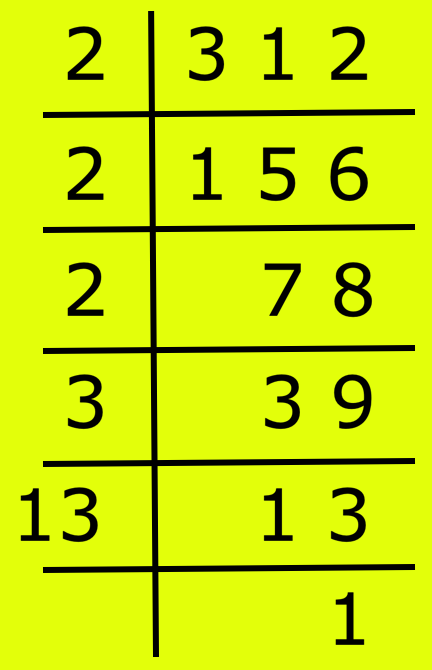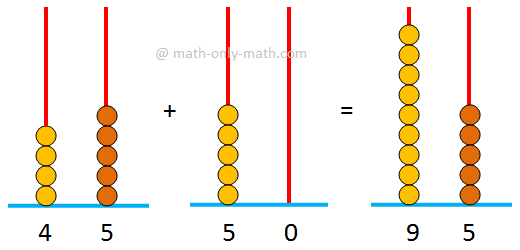Addition of Rational Number with Different Denominator
We will learn the addition of rational number with different denominator. To find the sum of two rational numbers which do not have the same denominator, we follow the following steps:
Step I: Let us obtain the rational numbers and see whether their denominators are positive or not. If the denominator of one (or both) of the numerators is negative, re-arrange it so that the denominators become positive.
Step II: Obtain the denominators of the rational numbers in step I.
Step III: Find the lowest common multiple of the denominators of the two given rational numbers.
Step IV: Express both the rational numbers in step I so that the lowest common multiple of the denominators becomes their common denominator.
Step V: Write a rational number whose numerator is equal to the sum of the numerators of rational numbers obtained in step IV and denominators is the lowest common multiple obtained in step III.
Step VI: The rational number obtained in step V is the required sum (simplify if required).
Following examples will illustrate the above procedure.
1. Add 47 and 5
Solution:
We have, 4 = 41
Clearly, denominators of the two rational numbers are positive. We now re-write them so that they have a common denominator equal to the LCM of the denominators.
In this case the denominators are 7 and 1.
The LCM of 7 and 1 is 7.
We have, 5 = 51 = 5×71×7 = 357
Therefore, 47 + 5
= 47 + 51
= 47 + 357
= 4+357
= 397
2. Find the sum: −56 + 49
Solution:
The denominators of the given rational numbers are 6 and 9 respectively.
LCM of 6 and 9 = (3 × 2 × 3) = 18.
Now, −56 = (−5)×36×3 = −1518
and 49 = 4×29×2 = 818
Therefore, −56 + 49
= −1518 + 818
= −15+818
= −718
3. Simplify: 7−12 + 5−4
Solution:
First we write each of the given numbers with positive denominator.
7−12 = 7×(−1)(−12)×(−1) = −712, [Multiplying the numerator and denominator by -1]
⇒ 7−12 = −712
5−4 = 5×(−1)(−4)×(−1) = −54, [Multiplying the numerator and denominator by -1]
⇒ 5−4 = −54
Therefore, 7−12 + 5−4 = −712 + −54
Now, we find the LCM of 12 and 4.
The LCM of 12 and 4 = 12
Rewriting −54 in the form in which it has denominator 12, we get
−54 = (−5)×34×3 = −1512
Therefore, 7−12 + 5−4
= −712 + −54
= −712 + −1512
= ((−7)+(−15)12
= −2212
= −116
Thus, 7−12 + 5−4 = −116
4. Simplify: 5/-22 + 13/33
Solution:
First we write each one of the given rational numbers with positive denominator.
Clearly, denominator of 13/33 is positive.
The denominator of 5/-22 is negative.
The rational number 5/-22 with positive denominator is -5/22.
Therefore, 5/-22 + 13/33 = -5/22 + 13/33
The LCM of 22 and 33 is 66.
Rewriting -5/22 and 13/33 in forms having the same denominator 66, we get
-5/22 = (-5) × 3/22 × 3, [Multiplying the numerator and denominator by 3]
⇒ -5/22 = -15/66
13/33 = 13 × 2/33 × 2, [Multiplying the numerator and denominator by 2]
⇒ 13/33 = 26/66
Therefore, 5/-22 + 13/33
= 22/-5 + 13/33
= -15/66 + 26/66
= -15 + 26/66
= 11/66
= 1/6
Therefore, 5/-22 + 13/33 = 1/6
If ab and cd are two rational numbers such that b and d do not have a common factor other than 1, i.e., HCF of b and d is 1, then
ab + cd = a×d+c×bb×d
For example, 518 + 313 = 5×13+3×1818×13 = 65+54234 = 119234
And −211 + 314 = (−2)×14+3×1111×14 = −28+33154 = 5154
● Rational Numbers
Introduction of Rational Numbers
Is Every Rational Number a Natural Number?
Is Every Rational Number an Integer?
Is Every Rational Number a Fraction?
Equivalent form of Rational Numbers
Rational Number in Different Forms
Properties of Rational Numbers
Lowest form of a Rational Number
Standard form of a Rational Number
Equality of Rational Numbers using Standard Form
Equality of Rational Numbers with Common Denominator
Equality of Rational Numbers using Cross Multiplication
Comparison of Rational Numbers
Rational Numbers in Ascending Order
Rational Numbers in Descending Order
Representation of Rational Numbers on the Number Line
Rational Numbers on the Number Line
Addition of Rational Number with Same Denominator
Addition of Rational Number with Different Denominator
Properties of Addition of Rational Numbers
Subtraction of Rational Number with Same Denominator
Subtraction of Rational Number with Different Denominator
Subtraction of Rational Numbers
Properties of Subtraction of Rational Numbers
Rational Expressions Involving Addition and Subtraction
Simplify Rational Expressions Involving the Sum or Difference
Multiplication of Rational Numbers
Properties of Multiplication of Rational Numbers
Rational Expressions Involving Addition, Subtraction and Multiplication
Reciprocal of a Rational Number
Rational Expressions Involving Division
Properties of Division of Rational Numbers
Rational Numbers between Two Rational Numbers
8th Grade Math Practice
From Addition of Rational Number with Different Denominator to HOME PAGE
Didn't find what you were looking for? Or want to know more information about Math Only Math. Use this Google Search to find what you need.
Recent Articles
-
5th Grade Factors and Multiples | Definitions | Solved Examples | Math
Mar 23, 25 02:39 PM
Here we will discuss how factors and multiples are related to each other in math. A factor of a number is a divisor which divides the dividend exactly. A factor of a number which is a prime number is… -
Adding 2-Digit Numbers | Add Two Two-Digit Numbers without Carrying
Mar 23, 25 12:43 PM
Here we will learn adding 2-digit numbers without regrouping and start working with easy numbers to get acquainted with the addition of two numbers. -
Worksheet on 12 Times Table | Printable Multiplication Table | Video
Mar 23, 25 10:28 AM
Worksheet on 12 times table can be printed out. Homeschoolers can also use these multiplication table sheets to practice at home. -
Vertical Subtraction | Examples | Word Problems| Video |Column Method
Mar 22, 25 05:20 PM
Vertical subtraction of 1-digit number are done by arranging the numbers column wise i.e., one number under the other number. How to subtract 1-digit number vertically? -
Worksheet on 11 Times Table | Printable Multiplication Table | Video
Mar 22, 25 05:08 PM
Worksheet on 11 times table can be printed out. Homeschoolers can also use these multiplication table sheets to practice at home.
● Rational Numbers - Worksheets
Worksheet on Equivalent Rational Numbers
Worksheet on Lowest form of a Rational Number
Worksheet on Standard form of a Rational Number
Worksheet on Equality of Rational Numbers
Worksheet on Comparison of Rational Numbers
Worksheet on Representation of Rational Number on a Number Line
Worksheet on Adding Rational Numbers
Worksheet on Properties of Addition of Rational Numbers
Worksheet on Subtracting Rational Numbers
Worksheet on Addition and
Subtraction of Rational Number
Worksheet on Rational Expressions Involving Sum and Difference
Worksheet on Multiplication of Rational Number
Worksheet on Properties of Multiplication of Rational Numbers
Worksheet on Division of Rational Numbers
Worksheet on Properties of Division of Rational Numbers
Worksheet on Finding Rational Numbers between Two Rational Numbers
Worksheet on Word Problems on Rational Numbers






New! Comments
Have your say about what you just read! Leave me a comment in the box below. Ask a Question or Answer a Question.